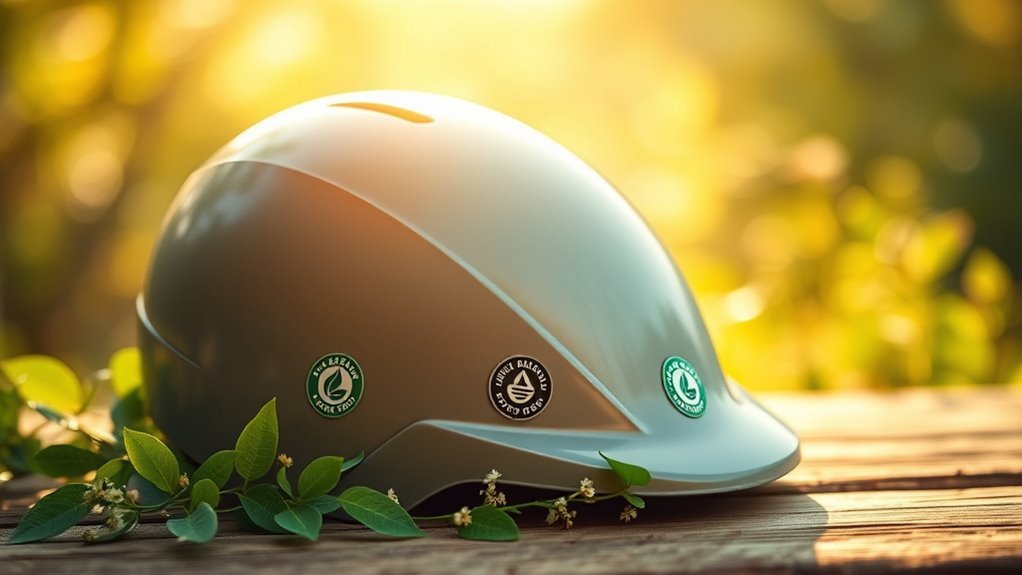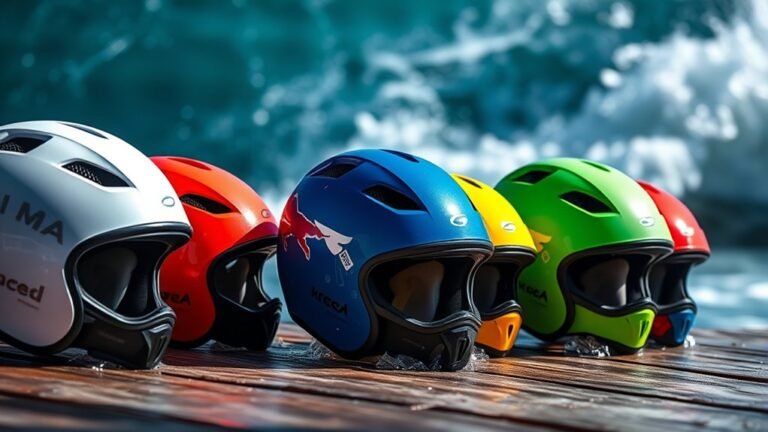Green Certifications for Eco-Friendly Helmets
When it comes to eco-friendly helmets, green certifications are key indicators of sustainability. Certifications like Cradle to Cradle and Green Seal guarantee manufacturers follow environmentally responsible practices. These labels assure that helmets are made from non-toxic, recyclable materials. By opting for certified products, you’ll support brands that prioritize both your safety and the planet’s health. Curious about which certifications are the most reliable? There’s plenty more to uncover in the world of sustainable helmet choices!
Understanding Green Certifications

When you’re choosing an eco-friendly helmet, understanding green certifications can make all the difference. These certifications reflect a manufacturer’s commitment to green initiatives and sustainable practices. To guarantee you’re making an informed choice, explore the certification processes that various organizations use. Look for labels that signify adherence to environmental standards, as they often assure that materials used are non-toxic and recyclable. Researching the criteria behind these certifications reveals the extent of a company’s dedication to sustainability. By doing so, you empower yourself to support brands that prioritize the planet while enjoying the freedom of safe riding. Ultimately, understanding these certifications helps you align your purchases with your values, making sure every ride contributes to a greener future.
Popular Eco-Friendly Helmet Certifications

Several key eco-friendly helmet certifications can guide your purchasing decisions, guaranteeing you choose a product that aligns with your values. Look for certifications like Cradle to Cradle, which emphasizes recycling initiatives and sustainable practices. Another notable certification is the Green Seal, focusing on reducing environmental impacts throughout a product’s lifecycle. The Forest Stewardship Council (FSC) certification verifies that materials come from responsibly managed forests, contributing to a healthier planet. By opting for helmets with these certifications, you support brands committed to minimizing waste and enhancing sustainability. Not only do you protect your head, but you also make a conscious choice that respects our environment. So, when shopping, keep these certifications in mind to make a positive impact.
The Importance of Sustainable Materials

While many may overlook the materials used in helmet production, choosing sustainable options can greatly impact both your safety and the environment. When you opt for helmets made from sustainably sourced materials, you’re not just making a fashion choice; you’re contributing to a larger movement towards eco-friendliness. Sustainable sourcing guarantees that the materials are responsibly harvested, reducing the ecological footprint. Plus, these materials often boast enhanced durability, meaning your helmet will last longer and require less frequent replacement. This durability not only protects your investment but also minimizes waste. By prioritizing sustainable materials, you’re embracing a lifestyle that values both personal safety and environmental responsibility, empowering yourself to ride freely without compromising the planet’s health.
Ethical Manufacturing Practices in Helmet Production
As consumers become more conscious of their choices, understanding the ethical manufacturing practices behind helmet production is essential. You should look for brands that prioritize supply chain transparency, ensuring that every step—from raw materials to final product—is ethically managed. This means not only sourcing sustainable materials but also respecting labor rights throughout the process. Manufacturers committed to ethical practices often provide information about their suppliers, factory conditions, and employee treatment, which helps build trust. By choosing helmets produced under ethical guidelines, you’re supporting a movement that values both environmental sustainability and human dignity. So, when you gear up, remember: your choice can make a difference in promoting a fairer, more responsible industry.
Choosing the Right Eco-Friendly Helmet for Your Needs
How can you be sure you’re choosing the right eco-friendly helmet for your specific needs? Start by considering helmet safety; it’s essential for any adventure. Look for models with high safety ratings and features like multi-impact protection. Next, dig into the eco-friendly features—are the materials sustainably sourced? Check for certifications that prove a commitment to the environment.
Think about your activity, too. Whether you’re biking, skateboarding, or hitting the slopes, the right fit and function matter. Explore adjustable straps and ventilation options for comfort. Finally, don’t forget to balance these aspects with your personal style. By focusing on safety and sustainability, you can confidently choose a helmet that protects you while aligning with your eco-conscious values.
Frequently Asked Questions
How Do Green Certifications Impact Helmet Performance and Safety?
Green certifications can enhance helmet performance metrics and safety standards. When you choose a certified helmet, you’re opting for products that meet rigorous testing and environmental criteria, ensuring better impact resistance and durability. These helmets often utilize innovative materials that not only protect but also minimize environmental harm. So, you’re not just safeguarding your head; you’re supporting sustainable practices that resonate with your desire for freedom and responsibility in your choices.
Are Eco-Friendly Helmets More Expensive Than Traditional Helmets?
Yes, eco-friendly helmets often cost more than traditional ones. When you explore a cost comparison, you’ll find that sustainable materials and ethical production can drive prices up. However, market trends show a growing demand for these helmets, which might lead to more competitive pricing in the future. Investing in an eco-friendly helmet not only supports the planet but can also mean better safety features, making it a worthwhile choice for your freedom on the road.
Can I Recycle My Old Non-Certified Helmet?
Yes, you can recycle your old non-certified helmet, but it depends on local recycling options. Many areas have specific guidelines for helmet disposal, as they’re often made from materials that aren’t easily recyclable. Check with your local recycling center to see if they accept them. If not, consider repurposing it or donating it to organizations that can use it for educational purposes. You’ll be making a positive impact, keeping freedom in mind!
What Brands Lead in Eco-Friendly Helmet Innovations?
When it comes to eco-friendly helmet innovations, you’ll find brands like Giro, Bell, and POC leading the charge. They’re crafting helmets with sustainable materials and innovative designs that not only protect you but also respect the planet. These companies are redefining safety gear, making it possible for you to enjoy your ride without compromising your commitment to the environment. So, why not choose a helmet that reflects your values and freedom?
How Can I Properly Care for My Eco-Friendly Helmet?
To properly care for your eco-friendly helmet, start with regular helmet maintenance. Clean it gently with mild soap and water, avoiding harsh chemicals that can damage sustainable materials. Inspect the helmet for any signs of wear or damage, as this can affect safety. Store it in a cool, dry place, away from direct sunlight. By taking these steps, you’ll not only extend your helmet’s life but also embrace the freedom of sustainable choices.






